Agricultural and Biological Research
RNI # 24/103/2012-R1
Research Article - (2024) Volume 40, Issue 2
Protected cultivation, sometimes referred to as polyhouse farming, is a common method for creating and preserving a controlled environment ideal for maximum crop productivity. Although protected farming produces crops with less resources than other methods, it still requires a lot of resources. This technology combines production system profitability with quality parameters that are driven by the market. Cucumis sativus or cucumbers, are a highly popular crop grown in naturally ventilated polyhouses in the mid-hills of Himachal Pradesh. This is because the cold temperatures in open fields and shed net houses result in low fruit yield and quality. Cucumbers are a very profitable crop in the early summer because of the high market price. The goal of the current study was to choose polyhouse cucumber hybrids that would be suited for early season harvest in Himachal's mid-hills. Therefore, an experiment was carried out in the off-season at the research farm of department of Agricultural Engineering, college of Agriculture, Chaudhary Sarwan Kumar Himachal Pradesh Krishi Vishvavidyalaya (CSKHPKV), Palampur to study the impact of transplanting date, planting geometry and training system on cucumber productivity under naturally ventilated polyhouse. The experiment was set up using a factorial randomized block design with three replications and it included eighteen treatments i.e., two planting geometries (60 cm × 30 cm and 75 cm × 30 cm), three training systems (two shoots, three shoots and four shoots) and three transplanting dates (1st fortnight of March, 2nd fortnight of March, 1st fortnight of April). Among the date of transplanting, significantly higher vine length, number of fruits per plant, fruit length (18.21 cm), fruit weight (177.86 g), fruit breadth (6.40) and fruit yield per plant (3.23 kg) was recorded under, 1st fortnight of March over 2nd fortnight of March and 1st fortnight of April. Highest fruit length (17.13 cm), fruit breadth (6.34 cm), fruit weight 175.52 g), number of fruits per plant (22.82) and fruit yield per plant (3.10 kg) was recorded under wider spacing (75 cm × 30 cm) than narrow spacing. With respect to the number of shoots per plant, plants with two shoots recorded significantly higher fruit length (17.61 cm), fruit breadth (6.39 cm), fruit weight (179.67 g). Whereas retaining three shoots per plant recorded significantly higher fruit yield per plant (3.48 kg).
Cucumber; Protected cultivation; Polyhouse; Training system; Yield
Around the world, cucumbers (Cucumis sativus L.), a popular vegetable are produced in both open and protected environments. Native to northwest India, cucumbers have been cultivated for at least 3,000 years. Its juice is often recommended as a source of silicon for healthy skin. Cucumbers are rich in minerals like magnesium, potassium, copper, phosphorus and manganese, as well as vitamins A, B, B5, C and K. Enriched in nutritious fiber and antioxidants, including flavonoids and tannins, which safeguard the crop from damaging free radicals and may reduce the chance of developing chronic illnesses. As a thermophilic plant, it prefers temperatures between 18-30 degrees Celsius and is susceptible to cold. Cucumbers are primarily composed of water and they help you stay more hydrated. Ascorbic acid and caffeine, which are also found in cucumbers, help to reduce skin irritation and swelling. Nonetheless, frost sensitivity in the winter months is also a common problem, resulting in damage and hindering productive farming. This restriction has a detrimental effect on the growth and fruit development. Protected cultivation methods in polyhouses have become a practical answer to these problems, providing a regulated environment ideal for crop growth and development [1]. India is a country with a tropical and subtropical climate; the country's year-round high temperatures make it challenging to grow superior grade vegetables in open environments. Protected farming is a unique and specialized form of agriculture where the needs of the plant species being farmed determine how much the microclimate around the plant is controlled. Cucumbers could be grown under protected cultivation to boost the vegetative growth, yield, quality and quantity. Cucumber mosaic virus and other insect pests severely affect seed crops grown in open fields and there is yet no effective control strategy for these pests. Owing to its adaptability and high yield under plastic house conditions, the majority of farmers began cultivating hybrid cucumbers in remote areas during the off-season in order to gain profitable returns. Yields are higher in naturally ventilated poly houses than in open fields. Pest problems related to insects in protected farming differ significantly from those in open fields. Furthermore, choosing the ideal date for transplanting has a significant impact on plant growth and development, which maximizes crop yield and maximizes the use of available land. The production of greenhouse cucumbers highlights the significance of utilizing available space and nutrients to improve yield per unit area through suitable crop density. Previous studies have demonstrated the effects of appropriate row spacing on crop yield and growth. Moreover, spacing influences not only plant characteristics, but also insect and weed interactions, disease susceptibility, soil conditions, germination and emergence.
Training approaches differ according to different plant densities, growth trends and cultivars of cucumbers. By implementing unique training systems, plants are better able to obtain the necessary sunshine, which in turn creates a favorable micro-environment and reduces the possibility of fungal and insect-related problems. In greenhouse cucumber cultivation, manipulating canopy structure through appropriate spatial arrangements-achieved through strategic training-emerges as a critical management strategy for producing desired and marketable yields. Therefore, the main issue with growing cucumbers in open fields is climate change; nevertheless, in protected environments, where the crop's microclimate is regulated, yield is increased. Thus, in order to help farmers in Himachal Pradesh's mid-hill regions during the off-season, the current study was conducted to examine the effects of planting geometry, training systems and transplanting dates on the growth behavior and fruit development parameters in cucumbers grown in naturally ventilated polyhouses.
The experiment was carried out at the research farm of department of agricultural engineering, college of agriculture, CSKHPKV, Palampur, during off season. The size of the polyhouse measured 20 meters in length and 12 meters in width, resulting in a total area of 240 square meters. Aluminium sheets were used to encapsulate this structure together with 200 micron-thick ultraviolet-stabilized low-density polyethylene sheets. The average yearly temperature is between 21.64°C and 37.07°C with minimum and maximum temperatures falling between 10.31°C and 24.00°C. On an average, the temperature within the greenhouse remained consistently 6.50°C higher compared to the external environment outside the polyhouse. The temperature within the greenhouse was consistently 6.50°C higher on average than the outside temperature of the polyhouse. The crop experienced fluctuations in relative humidity within the polyhouse, ranging from 35.1% to 77.8% during its growth phase. The experimental location was meticulously hand-prepared and tilled. 3.0 m × 1.2 m beds were carefully prepared and sterilized with a formalin solution containing 4%. The hybrid 'Isetis' seeds were planted in plastic plug trays filled with a soilless blend of vermiculite, perlite and coco peat in a 3:1:1 ratio. Following a 30 to 35 day’s transplantation period, the plants underwent two, three and four shoot training procedures, among other training approaches based on treatment changes. For staking, nylon threads were utilized. Growth, yield and commercial quality traits of commercial gynoceious and parthenocarpic (seedless) cucumber hybrid viz. Isetis was studied under naturally ventilated polyhouse condition.
Observations recorded
The following observations were recorded from experimental plots to assess the effect of treatments on growth, yield and quality of the product.
Vine length: Five plants were randomly selected from each plot and labeled. The height of these labeled plants was measured at 40, 60 and 80 Days After Transplanting (DAT), as well as at the final harvest. The mean vine length was determined by averaging these measurements.
Number of fruits per plant: During each harvest, all fruits from the five randomly chosen labeled plants in each plot were counted. The mean number of fruits per plant was calculated by dividing the total number of fruits by 5.
Fruit weight (g): At each harvest, fruits were taken from the labeled plants and their weights were recorded. The average fruit weight in grams was computed by dividing the overall marketable yield by the total number of fruits.
Fruit length (cm): During each harvest, ten fruits were randomly selected from five labeled plants in each plot and their length was measured in centimeters using a vernier caliper.
Fruit breadth (cm): Ten fruits were randomly chosen during each harvest from five labeled plants in each plot. Using a vernier caliper, the equatorial side fruit breadth was measured in centimeters. The mean fruit breadth was calculated by dividing the sum of these measurements by 10.
Fruit yield per plant (kg): At every harvest, fruits from five labeled plants were harvested and weighed separately. The yield per plant in kilograms was calculated by adding the total produce of the labeled plants in all plots during all harvests and dividing by the number of labeled plants in each plot.
Statistical analysis: The statistical significance of various effects was assessed at the 5% probability level using the Analysis of Variance (ANOVA). The significance of variation among treatments was determined using the statistical analysis approach.
Growth and development studies
Vine length (cm): Data on mean vine length (cm) at different crop stages, influenced by planting geometry, training techniques and transplanting dates (Figures 1a-1c). Typically, plants grew quickly for the first 80 DAT; after that, their rate of elongation abruptly decreased, giving the curve a sigmoid shape. The length of the vine was significantly affected by the transplanting dates. Plant growth occurred in a suitable temperature range, which may have attributed to the enhanced plant metabolic activities like photosynthesis due to favorable conditions. The second fortnight of March recorded significantly taller plants (39.74, 120.99, 162.26 and 174.26 cm at 40, 60, 80 DAT and at harvest) than transplanting in the first fortnight of March and the first fortnight of April.
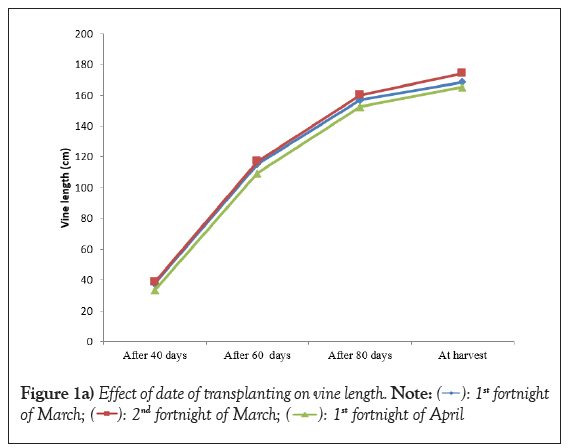
Figure 1a: Effect of date of transplanting on vine length. 
 .
.
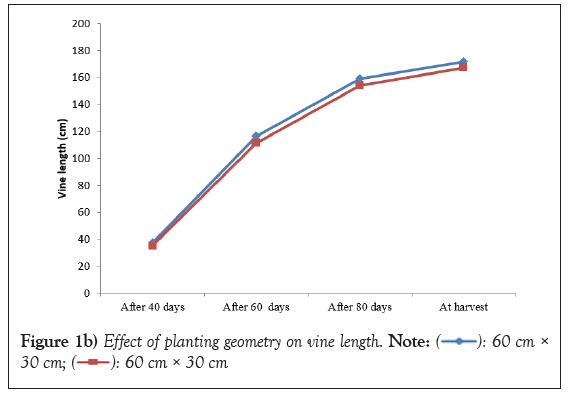
Figure 1b: Effect of planting geometry on vine length. 
 .
.
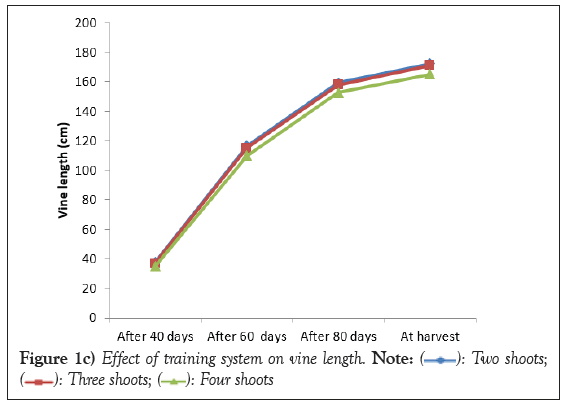
Figure 1c: Effect of training system on vine length. 
 .
.
According to Hao et al., [2], the ideal temperature range for cucumbers is between 25-30°C. Growth exceeds flower development when the temperature range is lower. Low temperatures (<18°C) and high temperatures (>30°C) during the early stages of vegetative growth, respectively, had an impact on plant height in the early (1st fortnight of March) and late (1st fortnight of April) transplanted crops. Similar results were also reported by Jaksungnaro et al., [3].
Plants spaced 60 cm × 30 cm produced significantly higher vine length (37.59, 116.30, 159.06 and 171.55 cm at 40, 60, 80 DAT and at harvest) than plants spaced at 75 cm × 30 cm at all the stages of crop growth. This could be because there is intense competition among the plants for light and space, which forces them to grow taller. There was greater growth area available, which allowed for the production of short, robust plants at wider spacing. Similar observations were also reported by Jaffar et al. [4], El-Shaikh [5], Aniekwe et al., [6] and Raveena et al., [7].
Vine length was also significantly influenced by training systems at all the growth stages. Among various training systems, highest vine length was recorded under plants trained to two shoots (37.76, 116.44, 159.21 and 172.14 at 40, 60, 80 DAT and at harvest) than three shoots and four shoots at all the stages. On the other hand, plants with four shoots recorded the minimum vine length. This longer vine with two shoots could be the result of side branch training, which would have decreased the amount of nutrients reaching the auxiliary branches and increased the amount reaching the apical tissues, elongating the shoot [8].
Planting geometry training system significantly influenced the vine length at 60 days after transplanting (Table 1). The highest vine length was recorded from three shoots trained plants spaced at 60 cm × 30 cm (122.49 cm) which was however statistically at par with the four shoots trained plants spaced at 75 cm × 30 cm.
| Planting geometry | Training system | ||
|---|---|---|---|
| Two shoots | Three shoots | Four shoots | |
| 60 cm × 30 cm | 110.65 | 122.49 | 115.76 |
| 75 cm × 30 cm | 109.13 | 107.8 | 117.12 |
| Sem ± | 2.07 | ||
| CD at 5% | 5.97 | ||
Note: Sem: Standard error of mean; CD: Critial Difference.
Table 1: Classification of water quality and status based on weighted arithmetic water quality index method.
Number of fruits per plant
Number of fruits per vines was significantly affected by different dates of transplanting, planting geometry and training systems (Figure 2).
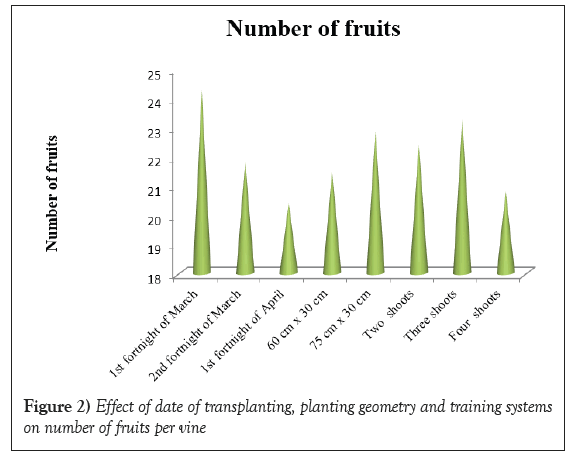
Figure 2: Effect of date of transplanting, planting geometry and training systems on number of fruits per vine.
Significantly more number of fruits per plant (24.25) was recorded under early transplanting in the 1st fortnight of March than later transplanting in the 2nd fortnight of March and 1st fortnight of April. Transplanting of cucumber in the 1st fortnight of March recorded an increase in fruits per plant of 11.8% and 19.4%, respectively, compared to transplanting of cucumber in 2nd fortnight of March and 1st fortnight of April, respectively. The reason for this could be that plants transplanted during the 1st fortnight of March produced the highest percentage of fruit setting and produced more flowers per plant. These results are in conformity with the findings of Kishor et al., [9].
The amount of fruits per vine was significantly influenced by planting geometry as well. Significantly more fruits were produced per plant (22.82) at a larger spacing of 75 cm × 30 cm than at a spacing of 60 cm × 30 cm. This could be because growth-promoting elements like nutrition, air and moisture are more widely available [10,11].
Different training systems also had significant influence on number of fruits per plant. Significantly higher number of fruits per plant (23.27) was recorded with the plants trained to three shoots than two and four shoots. This could be attributed to availability of more number of fruit producing shoots which resulted into higher number of fruits per plant in three shoots trained plants [12].
Planting geometry training system had significant effect on number of fruits per plant. Three shoots trained plants spaced at 75 cm × 30 cm significantly recorded the higher number of fruits per plant which was statistically at par with three shoots trained plants spaced at 60 cm × 30 cm and two shoots trained plants spaced at 75 cm × 30 cm (Figure 3).
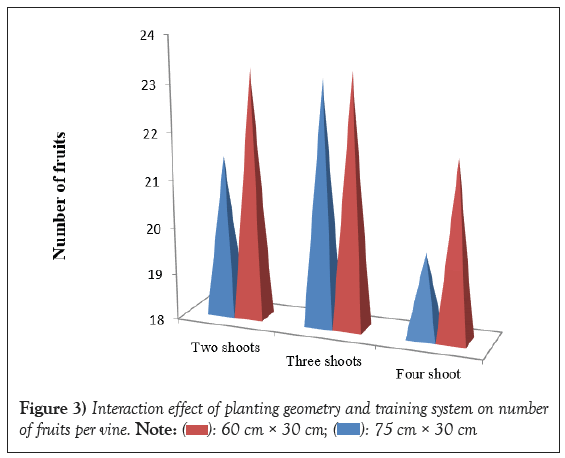
Figure 3: Interaction effect of planting geometry and training system on number
of fruits per vine.  .
.
Fruit weight (g): The data on fruit weight as influenced by different date of transplanting, plant geometry and training system have been depicted graphically in Figure 4.
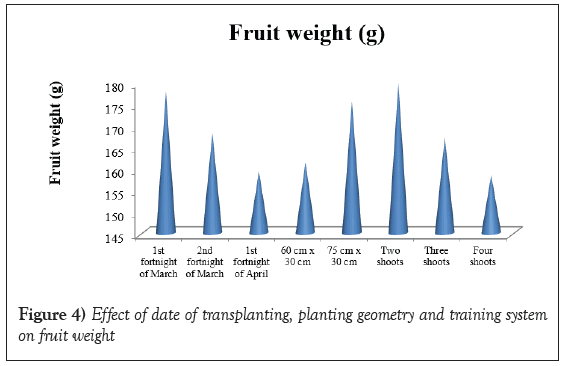
Figure 4: Effect of date of transplanting, planting geometry and training system on fruit weight.
Significantly higher fruit weight (177.86 g) was recorded with the plants transplanted in the 1st fortnight of March than the fruits obtained from the 2nd fortnight of March and 1st fortnight of April. This was due to the more fruit breadth and length produced by the plants transplanted in the 1st fortnight of March.
Planting geometry also had significantly influence on the fruit weight of cucumber. Fruits produced at wider spacing of 75 cm × 30 cm had significantly more weight (175.52 g) than narrow spacing of 60 cm × 30 cm (161.41 g). Fruit size is ultimately governed by its length and width, however it could be possible that fruits are able to absorb more nutrients and collect enough photosynthates to allow for an increase in fruit size. The results are in conformity with the findings of Aniekwe et al. [6], Kapuriya et al., [11] and Mantur et al., [13]. Different training systems also had significant effect on fruit weight. Plants with two shoots recorded significantly higher fruit weight (179.67 g) than three (167.27 g) and four shoot plants (158.45 g). Additionally, there were substantial differences between the two subsequent training systems. When three shoot plants were used instead of four shoot plants, a noticeably greater fruit weight was observed. The heavier fruits that were harvested from the two shoot plants were probably the result of enhanced light exposure, enhanced photosynthetic production and enhanced absorption of carbohydrates [6,10].
Planting geometry training system significantly influenced the fruit weight (Figure 5). Three shoots trained plants spaced at 75 cm × 30 cm significantly recorded the higher fruit weight which was statistically at par with two shoot trained plants with both the spacings.
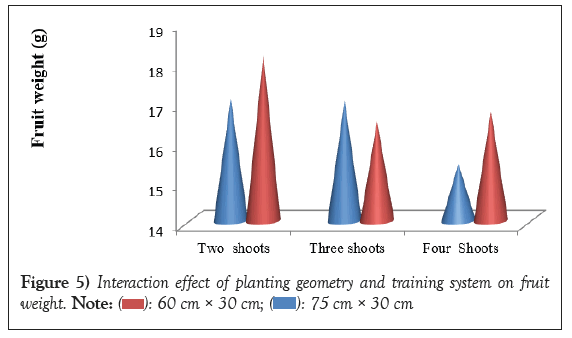
Figure 5: Interaction effect of planting geometry and training system on fruit
weight.  .
.
Fruit length (cm): The data on fruit length (cm) as influenced by different treatments have been presented in Figure 6.
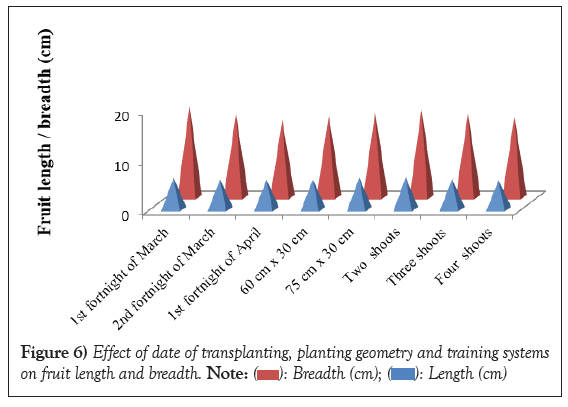
Figure 6: Effect of date of transplanting, planting geometry and training systems
on fruit length and breadth.  .
.
An examination of data in Figure 6. indicated that the effect of different dates of transplanting was significant on fruit length (18.21 cm). Crop transplanted in the 1st fortnight of March observed significant increase in fruit length than the crop transplanted in the 2nd fortnight of March and 1st fortnight of April. Later two dates of transplanting also differed significantly. This might be due to the translocation of more photosynthates from source to sink and also favorable microclimate that prevailed throughout the crop growth period of the crop transplanted in the 1st fortnight of March. The results corroborate with the findings of Raveena et al., [7].
Fruits grown with a wider spacing of 75 cm × 30 cm were much longer (17.13 cm) than those grown with a narrower spacing of 60 cm × 30 cm (Figure 6). Longer fruits could be the result of favorable environmental factors such light, moisture and nutrients as well as reduced plant competition when spaced more widely [4,6].
Fruit length was significantly impacted by various training schemes. Due to a larger source to sink ratio, the maximum fruit length was achieved in two shoot plants (17.61 cm), followed by three shoot plants (16.75 cm) and four shoot plants (16.08 cm). The two shoot plants had an adequate supply of assimilates for the young fruits; but, under the three and four shoot plants, the sink to source ratio was low. Therefore, there was less assimilates available because of the greater sink, which directly affected the fruit's length. Similar observations were also recorded by Raveena et al., [7] and Hoza et al., [14].
Fruit breadth (cm): The data on fruit breadth as influenced by different treatments have been presented in Figure 6.
Dates of transplanting had a major impact on fruit breadth. Compared to crops transplanted in the 2nd fortnight of March and 1st fortnight of April, the crop transplanted in the 1st fortnight of March showed a notable increase in fruit breadth (6.40 cm). This could be because more photosynthates were moved from the source to the sink throughout the growth period of the crop that was transplanted in the first two weeks of March, as well as because of the favorable microclimate that persisted during that time [7].
Planting geometry also had a significant influence on the fruit breadth. The fruits produced at a spacing of 75 cm × 30 cm had significantly higher breadth (6.34 cm) than narrow spacing of 60 cm × 30 cm (5.90 cm). It may be due to less competition among plants for growth factors in wider spacing as reported by Abubaker et al., [15].
Different training systems also had a substantial impact on fruit breadth. Two shoot plants had the largest fruit breadth (6.39 cm), followed by three shoot plants (6.13 cm) and four shoot plants (5.84 cm). This could be because the source to sink ratio was higher in the two shoot plants. In two shoot plants, there was an adequate supply of assimilates for the developing fruits; however, under three and four shoot plants, the situation was the opposite, with a high sink to source ratio. Therefore, there was less assimilates available because there was more sink, which directly affected the fruit's breadth. The findings of Santi et al., [16] corroborates the above results.
Interactions under study could not influence fruit breadth significantly.
Fruit yield per plant (kg): The data pertaining to fruit yield per plant as influenced by date of transplanting, planting geometry and training system have been depicted graphically in Figure 7.
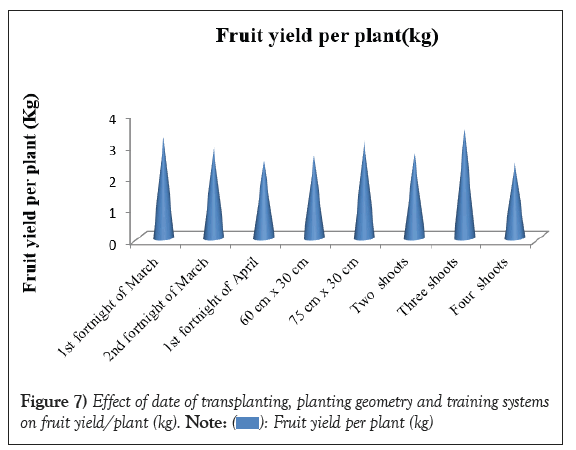
Figure 7: Effect of date of transplanting, planting geometry and training systems
on fruit yield/plant (kg).  .
.
Analysing the data showed that when the crop was transplanted later-from the 1st fortnight of March to 2nd fortnight of March and further to 1st fortnight of April, the fruit production per plant dramatically dropped. When the crop was transplanted during the 1st fortnight of March, the maximum fruit output of 3.23 kg was achieved. Compared to transplanting dates later, this yield was noticeably higher. This may be related to the favorable weather that persisted during the crop's growth period after it was transplanted in the 1st fortnight of March, which increased vegetative growth and produced more flowers, fruits per plant, maximum fruit weight and fruit volume. Similar results were obtained by Raveena et al. [7], Singh et al., [17] and Eifediyi et al., [18].
Planting geometry also had a significant effect on fruit yield/plant. The crop planted at a spacing of 75 cm × 30 cm produced significantly higher fruit yield/plant (3.10 kg) than the crop planted at a spacing of 60 cm × 30 cm (2.63 kg). The crop planted at a closer spacing (60 cm × 30 cm) produced minimum fruit yield/plant. The reason for the higher fruit yield/plant may probably be due to less competition for light, nutrients, water and space in wider row-spacing compared to closer one. Similar results were also reported by Kapuriya et al. [11], Devi et al., [19] and Nerson [20].
Yield per plant is one of the most important factor which attributes to the yield per unit area. Improvement in quality and increase in yield will ultimately decide the practical utility of adopting different training systems in combination with varying plant population per unit area as observed that spacing in cucumber was linked with the method of training.
There was a significant influence of various training systems on per plant yield. Significantly higher fruit yield/plant (3.48 kg) was recorded in three shoot plants than two and four shoot plants. Training to two shoots might have resulted in excessive removal of branches thus affecting the photosynthates capacity. Similar observations were also reported by Lopez et al., [21].
Protected cultivation, also known as polyhouse farming, is a method for maximizing crop productivity by creating a controlled environment. Cucumis sativus, a popular crop in Himachal Pradesh, is grown in naturally ventilated polyhouses due to low fruit yield and quality. A study was conducted to select polyhouse cucumber hybrids suitable for early season harvest in Himachal's mid-hills. The experiment involved 18 treatments, including two planting geometries, three training systems and three transplanting dates. Results showed that different dates of transplanting led to higher vine length, fruit length, fruit weight, fruit breadth and fruit yield. Wider spacing resulted in higher fruit length, fruit breadth and fruit weight.
Citation: Raveena. Maximizing cucumber (Cucumis sativus L.) productivity: A study on the influence of transplanting dates, planting density and training techniques in naturally ventilated polyhouses of Himachal Pradesh. AGBIR.2024;40(2):999-1003.
Received: 28-Feb-2024, Manuscript No. AGBIR-24-130125; , Pre QC No. AGBIR-24-130125 (PQ); Editor assigned: 01-Mar-2024, Pre QC No. AGBIR-24-130125 (PQ); Reviewed: 15-Mar-2024, QC No. AGBIR-24-130125; Revised: 22-Mar-2024, Manuscript No. AGBIR-24-130125 (R); Published: 29-Mar-2024, DOI: 10.35248/0970-1907.24.40.999-1003
Copyright: This open-access article is distributed under the terms of the Creative Commons Attribution Non-Commercial License (CC BY-NC) (http:// creativecommons.org/licenses/by-nc/4.0/), which permits reuse, distribution and reproduction of the article, provided that the original work is properly cited and the reuse is restricted to noncommercial purposes. For commercial reuse, contact reprints@pulsus.com This is an open access article distributed under the terms of the Creative Commons Attribution License, which permits unrestricted use, distribution, and reproduction in any medium, provided the original work is properly cited.
